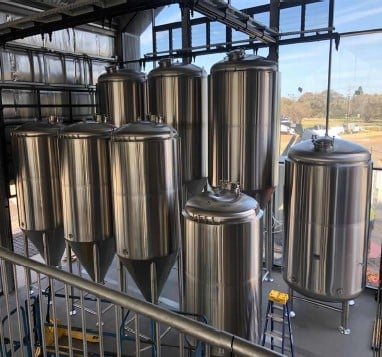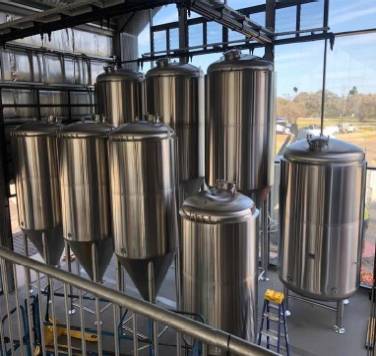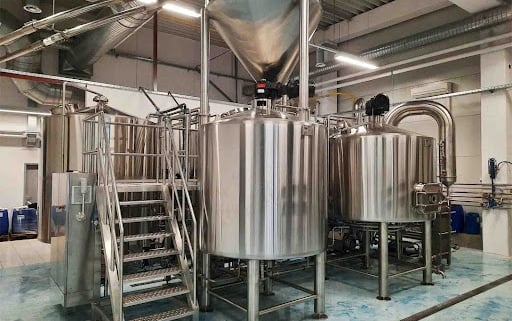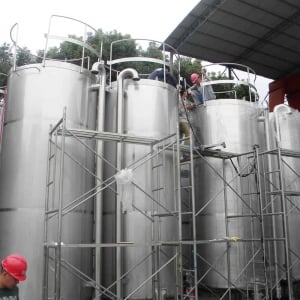Stainless Steel Conical Tanks
Stainless steel conical tanks, also known as conical fermenters, are workhorse vessels used across various industries for storing, mixing, processing, and fermenting liquids. Their distinctive cone-shaped design offers numerous advantages over traditional cylindrical tanks, making them a popular choice for applications in food and beverage production, pharmaceuticals, chemicals, and more. This guide delves deep into the world of stainless steel conical tanks, exploring their intricacies, applications, and everything in between.
Overview
- Core Function: Stainless steel conical tanks serve as versatile vessels for storing, processing, and fermenting liquids.
- Distinguishing Feature: The conical bottom facilitates complete drainage and minimizes sediment buildup, making them ideal for tasks requiring efficient product recovery.
- Material Advantage: Stainless steel offers superior durability, corrosion resistance, and cleanability, ensuring product purity and tank longevity.
Applications of Stainless Steel Conical Tanks
Stainless steel conical tanks find extensive use in a diverse range of industries due to their functionality and versatility. Here’s a glimpse into some of their prominent applications:
| Industry | Application |
|---|---|
| Food and Beverage | Beer fermentation, wine fermentation, juice processing, dairy processing, edible oil storage |
| Pharmaceutical | Bioreactors, media preparation, pharmaceutical intermediate storage |
| Chemical | Resin mixing, dye preparation, chemical processing |
| Wastewater Treatment | Sludge settling, digestion processes |
| Other Industries | Biodiesel production, paint mixing, cosmetic production |
Understanding the Benefits: The conical shape promotes complete drainage and minimizes liquid hold-up in the bottom cone, unlike cylindrical tanks where pockets of liquid can linger. This is particularly crucial in fermentation processes where sediment separation and complete product recovery are essential. Additionally, the smooth, non-porous surface of stainless steel allows for easy cleaning and sanitation, preventing contamination and ensuring product quality.

Features of Stainless Steel Conical Tanks
Conical tanks come equipped with various features to enhance their functionality and cater to specific process needs. Here’s a breakdown of some key features:
- Capacity: Ranges from small-scale 9-gallon tanks for home brewing to massive industrial tanks exceeding 50,0 gallons, catering to diverse production volumes.
- Material Grade: Typically constructed from food-grade 304 or 316 stainless steel, ensuring product safety and corrosion resistance.
- Jacketing: Jacketed tanks feature a double wall construction with a space in between that allows for the circulation of heating or cooling fluids for temperature control during processing.
- Insulation: Jacketed tanks can be further insulated to minimize heat transfer and maintain consistent temperatures.
- Lids: May be flat or domed, and equipped with hatches or manways for access during cleaning or maintenance.
- Valves: Inlet and outlet valves for filling, discharging, and sampling liquids.
- Fittings: May include drain ports, spray balls for cleaning, and pressure relief valves for safety.
- Finish: Interior surfaces are typically polished to a smooth finish for optimal cleanability, while exteriors may have a brushed or matte finish.
Customization Options: Conical tanks can be customized to meet specific needs. Options include varying capacities, material grades, jacketed or non-jacketed configurations, different insulation levels, and a range of valves and fittings.
Brewing Process with Stainless Steel Conical Tanks
Stainless steel conical tanks play a vital role in the brewing process, particularly in craft beer production. Here’s a simplified breakdown of their involvement:
- Wort Transfer: After the wort (unfermented beer) is boiled and cooled, it’s transferred from the brew kettle to the conical fermenter.
- Yeast Pitching: Yeast is introduced into the wort to initiate fermentation.
- Fermentation: During fermentation, the yeast consumes the sugars in the wort and produces alcohol and carbon dioxide. The conical bottom facilitates the settling of yeast and sediment throughout the process.
- Maturation (Secondary Fermentation): After primary fermentation, the beer may undergo a secondary fermentation in the conical tank for further conditioning and flavor development.
- Dry Hopping (Optional): Hops may be added during this stage for additional aroma and flavor.
- Transfer and Packaging: Once fermentation is complete, the clarified beer is transferred to conditioning tanks, kegs, or bottles for packaging.
Advantages for Brewers: Conical tanks offer several advantages to brewers. The conical bottom promotes efficient yeast and sediment separation, leading to clearer beer.
Factors Affecting Stainless Steel Conical Tank Price Range
The cost of a stainless steel conical tank varies depending on several factors. Here’s a table outlining these key considerations:
| Factor | Impact on Price |
|---|---|
| Capacity | Larger tanks naturally cost more due to increased material usage and fabrication complexity. |
| Material Grade | 316 stainless steel, with its higher molybdenum content for enhanced corrosion resistance, is generally more expensive than 304 stainless steel. |
| Jacketing and Insulation | Jacketed tanks with insulation incorporate additional components and construction steps, leading to a higher price point compared to non-jacketed tanks. |
| Features and Fittings | The inclusion of features like multiple valves, spray balls, instrumentation, and advanced pressure control systems increases the overall cost. |
| Customization | Custom tanks with unique dimensions, material specifications, or special fittings will command a premium compared to standard models. |
| Manufacturer and Brand Reputation | Reputable brands with a proven track record of quality and customer service may have slightly higher prices compared to lesser-known manufacturers. |
Price Range Examples:
- Small-scale home brewing tanks (9 gallons): $250 – $500 range
- Medium-sized tanks (50-500 gallons): $1,000 – $10,000 range (depending on features)
- Large industrial tanks (over 5,000 gallons): Can reach $50,000 or more depending on size, features, and customization.
Additional Considerations:
It’s important to remember that the initial purchase price is just one factor to consider. Factors like maintenance costs, energy efficiency (jacketed tanks), and durability can also impact the total cost of ownership over time.
Installation, Operation, and Maintenance of Stainless Steel Conical Tanks
Installation:
- Stainless steel conical tanks typically require a solid, level foundation for proper support.
- Plumbing connections for inlet, outlet, drain, and cooling/heating lines (if jacketed) need to be established.
- Electrical connections may be required for controls, agitation systems (if present), and instrumentation.
Operation:
- Operating procedures will vary depending on the specific application and tank features.
- General steps may involve filling, adding ingredients (yeast, hops, etc.), temperature control (jacketed tanks), and monitoring pressure and fermentation progress.
- Safety protocols should be strictly followed, including proper personal protective equipment (PPE) usage and adherence to pressure relief procedures.
Maintenance:
- Regular cleaning and sanitation are crucial to maintain product purity and tank longevity.
- Cleaning procedures will depend on the specific application and materials processed.
- Regular inspections should be conducted to identify potential wear and tear issues and schedule maintenance as needed.
Resources: Manufacturers typically provide installation guides and operation manuals specific to their tank models. Consulting industry best practices and regulatory guidelines is also recommended.
Choosing the Right Stainless Steel Conical Tank Supplier
Selecting the right supplier for your stainless steel conical tank is crucial. Here’s a table outlining key factors to consider:
| Factor | Importance |
|---|---|
| Reputation and Experience | Choose a supplier with a proven track record in manufacturing high-quality stainless steel conical tanks for your specific industry application |
| Product Range and Customization Options | Ensure the supplier offers tanks in the desired capacity, material grade, and features you require. Explore customization options to tailor the tank to your exact needs |
| Engineering Expertise | A reputable supplier should have engineering expertise to advise on tank design, material selection, and compatibility with your process requirements |
| Manufacturing Quality | Look for a supplier that adheres to strict quality control standards to ensure consistent tank performance and durability |
| Customer Service | Prioritize suppliers with responsive customer service to address questions, provide after-sales support, and assist with troubleshooting if needed |
Pros and Cons of Stainless Steel Conical Tanks
Advantages:
- Efficient Liquid Discharge: The conical bottom design minimizes liquid hold-up and facilitates complete drainage, essential for applications like fermentation where separating solids from liquids is critical.
- Enhanced Cleanability: The smooth, non-porous surface of stainless steel minimizes product adhesion and promotes easy cleaning and sanitation, reducing the risk of contamination and ensuring product quality.
- Durability and Corrosion Resistance: Stainless steel offers superior durability and resistance to corrosion, ensuring a long service life for the tank.
- Temperature Control (Jacketed Tanks): Jacketed tanks allow for precise control of liquid temperatures through the circulation of heating or cooling fluids, crucial for temperature-sensitive processes like fermentation.
- Versatility: Stainless steel conical tanks find application across various industries due to their functional design and customization options.
Disadvantages:
- Higher Cost Compared to Cylindrical Tanks: The conical shape requires more material and complex fabrication techniques, leading to a higher initial price point compared to cylindrical tanks of similar capacity.
- Potential Settling Issues (Certain Applications): While the conical design aids in settling solids, some applications with very fine particles may still require additional processing steps for complete separation.
- Cleaning Challenges (Larger Tanks): Cleaning large conical tanks can be more labor-intensive than smaller tanks and may require specialized cleaning procedures or equipment.
Choosing the Right Tank Type
The decision between a conical tank and a cylindrical tank depends on your specific application requirements. Here’s a quick comparison to guide your choice:
| Feature | Conical Tank | Cylindrical Tank |
|---|---|---|
| Liquid Discharge | Excellent | Good |
| Cleanability | Excellent | Good |
| Durability | Excellent | Excellent |
| Temperature Control (Jacketed Models) | Excellent | Good (External heating/cooling required) |
| Cost | Higher | Lower |
| Solid Settling (Certain Applications) | More Efficient | Less Efficient |

FAQs
Q: What is the difference between 304 and 316 stainless steel for conical tanks?
A: Both 304 and 316 are common grades of stainless steel used for conical tanks. 304 offers excellent corrosion resistance for most applications. However, 316 includes molybdenum, providing enhanced resistance to specific chemicals and chlorides, making it a better choice for harsher environments or processes involving such elements.
Q: Do I need a jacketed conical tank?
A: Jacketing is essential if your process requires precise temperature control for optimal results. Fermentation and chemical reactions are prime examples where jacketing ensures consistent temperatures throughout the process. If temperature control is not critical for your application, a non-jacketed tank may be sufficient.
Q: What size conical tank do I need?
A: The ideal tank size depends on several factors:
- Production Volume: Consider your typical batch size and how many batches you plan to process per day/week/month. Choose a tank with sufficient capacity to accommodate your production needs.
- Available Space: Measure your designated space for the tank and factor in clearance for maintenance access.
- Future Expansion: If you anticipate increased production in the future, opting for a slightly larger tank provides room for growth without needing to replace the tank entirely.
Q: How do I clean and maintain my conical tank?
A: Cleaning procedures depend on the specific materials processed in the tank. Generally, a multi-step cleaning process involves:
- Rinsing: Remove any leftover product residue with water rinses.
- Cleaning Solution: Circulate a cleaning solution appropriate for the processed material to remove stubborn contaminants.
- Sanitization: Sanitize the tank interior using approved sanitizing agents to eliminate microorganisms.
- Rinsing (Final): Perform thorough final rinses with clean water to remove any cleaning solution traces.
Consulting the manufacturer’s cleaning guidelines specific to your tank model is highly recommended. Additionally, regular inspections for wear and tear and timely maintenance ensure optimal tank performance and longevity.
Q: What safety precautions should I take when using a conical tank?
A: Stainless steel conical tanks can hold large volumes of liquid and may be pressurized (jacketed tanks). Here are some crucial safety practices:
- Follow all manufacturer’s instructions for safe operation and maintenance.
- Wear appropriate personal protective equipment (PPE) such as gloves, goggles, and safety footwear during operation and maintenance.
- Never exceed the tank’s rated pressure capacity.
- Ensure pressure relief valves are functioning properly.
- Be aware of potential hazards associated with the liquids being processed and take appropriate precautions.
- Only trained personnel should operate and maintain the conical tank.
Conclusion
Stainless steel conical tanks represent versatile and reliable workhorses across various industries. Their functional design offers numerous advantages for applications demanding efficient liquid drainage, enhanced cleanability, and precise temperature control. By understanding the key considerations outlined in this guide, you can make an informed decision when selecting the right stainless steel conical tank to meet your specific needs.













